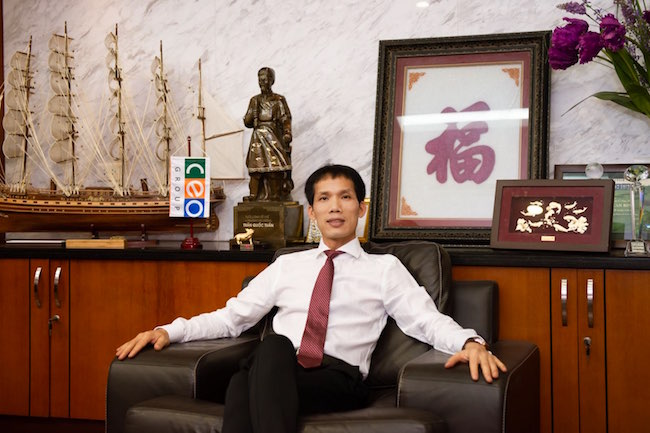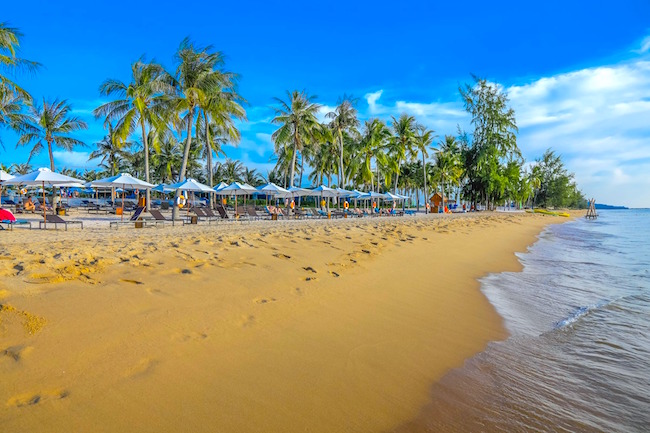Vietnam turns semiconductor vision into action
The global semiconductor industry is being reshaped by geopolitical tensions, shifting supply chains, and the surge of digital technologies.




Vietnam needs to have a more ambitious strategy with breakthrough thinking to elevate tourism industry to a new impetus for economic growth.
Vietnam tourism has achieved miraculous growth over the last couple of years and recorded 18 million international arrivals last year, far exceeding the number of 10 million foreign tourists for the year 2020 as forecast in the tourism development strategy, which was approved by the government in 2011.
With the number of domestic tourists reaching 85 million, tourism has gained $30.5 billion in revenue, equivalent to 10 per cent of GDP. As such, tourism is really a money maker and a driver of the country’s economic growth.

More than a money maker
In fact, tourism has become an export that brings higher net flow of foreign income into the country than overseas remittances or disbursement of foreign direct investment.
According to the World Bank, for each dollar of direct visitor spending on tourism-linked activities, a portion goes towards imported goods and services, meaning its direct contribution to GDP in generally less then on-for-one. In Vietnam, this tourism leakage factor has been relatively, around 0.27 per cent per dollar.
As a result, tourism is estimated to bring in more than $20 billion net foreign income last year, exceeding the overseas remittance of $17.6 million and equalling disbursement of foreign direct investment.
Net flow of foreign income generated by tourism is also higher than export surplus. Although the country’s tourism import-export value last year exceeded $500 million, or doubling the country’s GDP, the trade surplus for the whole year was around $10 billion.
These figures once again affirm the fact that tourism together with agriculture and information technology is one three key drivers of the country’s economic growth as reiterated by the government many times.
It’s worth noting that agriculture will face lots of challenges in the next few years as a result of trade wars and technical barriers along with the African swine fever and the country’s small-scale production and obsolete post-harvest technologies.
The information technology development depends a lot on the disbursement of foreign direct investment from Korea and Japan. In addition, trade surplus of this sector is only a few billion dollars.
Tourism is not only a driver of economic growth, but also generator of jobs general prosperity.
If agriculture is only developed in rural areas and industry in good infrastructure areas with a high population, tourism can develop in every area, using young labour forces. In particular, tourism can develop in remote and poor areas, thus becoming a tool to redistribute income from richer to poorer areas of the country.
The World Tourism Organization forecasts that the global tourism industry will grow 4 per cent on average in the next 10 years. The Southeast Asian region will benefit greatly from this development with the number of tourists expected to rise from 137 million last year to 187 million.
Situated in a golden location in Southeast Asia and having a stable and safe political environment, a population of nearly 95 million, a diversity of cultural heritages and beautiful natural landscapes, Vietnam is able to develop tourism into a strategic economic sector and a motivator of social-economic development.
Despite strong growth over the last few year, Vietnam’s tourism industry is still lagging far behind other giants in Southeast Asia. The number of international visitors to Vietnam is equal to only Indonesia and Singapore and much lower than Malaysia’s and just half of Thailand’s.
As other countries in the region are also giving priorities to tourism development, Vietnam will face stiff competition in attracting tourists and it needs to designed a breakthrough strategy to elevate tourism to a new height.
Policy breakthroughs needed
The tourism boom in the last few years had made the targets set for 2020 as approved nine years ago out of date.
Considering inherent strengths, Vietnam can work out a more ambitious tourism development strategy with the aim to turn the country into the world’s tourism powerhouse. This is an aspiration we are confident to realize if the government creates innovational policies.
In order to be on the list of the world's tourism powerhouses, Vietnam’s tourism development level must be equivalent to that of Thailand. The gap between the two countries at present remains big, but tourism is an economic sector that Vietnamese enterprises and people are entirely able to develop, with global competitiveness.
Tourism can be compared to football. Vietnam’s football was generally left behind Thailand in the past but it has proven the possibility to reach the top in Southeast Asia as a result of training young players and having an excellent coach that helps it win the AFF 2018 championship and SEA Games 30 gold medal. If tourism is guided by breakthrough policies and thinking, it can grow miraculously.
First, Vietnam need to open more widely its gate to welcome international visitors by expanding its unilateral visa exemption. There have been a lot of analysis on economic benefits of visa exemption in comparison with visa fees, but until now Vietnam has exempted visa for 26 countries while Thailand exempted visa for 57 countries, Indonesia 168, Malaysia 162 and the Philippines 132.
Therefore, Vietnam needs to continue expanding the unilateral visa exemption for most of the large and potential tourism markets as Phu Quoc is doing. Currently, Phu Quoc is a sole locality in Vietnam to pilot visa-free exemptions for all countries with 30-day stay and together with a well-developed infrastructure system, the number of international visitors to Phu Quoc has skyrocketed in the last few years.

Tourism cannot accelerate sharply without an improvement in the infrastructure system. Currently, Vietnam has 22 airports but their total capacity is just equal to Singapore’s Changi airport or Thailand’s Sunarvabhumi airport.
The country’s two main gateways, Tan Son Nhat and Noi Bai airports, have showed signs of being overloaded while airports in other localities are still undeveloped.
However, it is impossible to rely upon state budget forever and policies are needed to encourage and attract investment from the private sector to develop transportation infrastructure.
When private companies participate to build Danang or Cam Ranh passenger terminals and new Van Don airport, tourism in these localities have grown impressively. The participation of private airlines is also becoming a driving force for tourism growth.
However, the government needs to have practical actions to encourage further investment from private sector to improve the infrastructure system for the sake of tourism services.
The country’s hotel accommodation system has developed quickly, from 256,000 rooms in 2011 to 550,000 rooms in 2018, but more than two-thirds of rooms are low standard. Most hotels in Vietnam are of small scale while the number of international-brand hotels is much lower than that in Thailand, Singapore or Malaysia. To develop tourism, it is necessary to increase the size of the accommodation system while concurrently diversifying brands and improving quality.
The development of condotels and tourism properties over the last few years has attracted idle cash from individuals to build high-quality accommodation. However, it is urgently necessary to develop a legal framework related to land, ownership, use rights, construction standards as well as operation regulations of these new accommodation models so that investors are secured.
The country needs to diversify products and increase attractiveness in international tourism markets. So far, Vietnam's tourism has been largely developed thanks to the exploitation of natural resources and has not created many tourist products of great attraction.
Meanwhile, other countries are always refreshing products and image to attract visitors. Singapore for instance, has been very successful in organizing major events as well as building remarkable landmarks such as Marina Bay Sands, Botanic Garden and a new airport terminal in order to increase attractiveness and diversify experience for tourists.
Dubai has continuously created the world's most impressive and iconic works to attract tourists such as the world's tallest building Khalifa, palm-tree Island and world-shaped island.
Therefore, Vietnam needs to build more remarkable construction works to such as casinos, cable car systems, international branded entertainment parks similar to Disneyland and Universal. Major events such as Formula One racing to be held in Hanoi in the next few months will have a positive impact on tourism in Vietnam.
Vietnam has advantages in landscape, food and people that have created the attractiveness for its tourism, but tourism cannot speed up naturally. It is necessary to promote Vietnam's image to the world. Singapore, Thailand and Malaysia spend hundreds of millions of dollars on tourism marketing while Vietnam spends only $2 million a year.
Tourism also needs to have a good labor force, particularly high qualified staff who are able to speak different foreign languages.
Vietnamese businesses today can build high-quality hotels but providing good services remains a great challenge. Therefore, it is necessary to raise awareness of people and authorities, as well as establish practical education system in such a way that everyone is able to work in the tourism sector and the workmanship of staff is enhanced.
Much is needed to be done to make tourism truly become a key economic pillar of the country and turning the goal of Vietnam becoming a tourism powerhouse into reality.
Now is the time to build a tourism development strategy with a longer vision, more ambitious goals and innovational policies in an international way. One vision has its own strategy and a new strategy is urgently needed with a new goal to turn the aspiration for a powerful tourism country into reality.
The global semiconductor industry is being reshaped by geopolitical tensions, shifting supply chains, and the surge of digital technologies.
The change in APA approval authority is expected to shorten processing time and enhance business proactiveness in international tax negotiations.
As hybrid cloud systems grow more complex, Vietnamese enterprises are struggling to detect cybersecurity threats moving laterally within their own networks.
The submission of the draft resolution on Vietnam’s international financial center to the National Assembly heralds a new developmental era for the country.
More than just running a 5-star resort, Kristian Petersen is redefining the art of hospitality with a humane and sustainable leadership philosophy.
For Tyna Huynh, co-founder of Drinkizz, organic is not just a food choice but a way of life that fosters a deep connection between people, nature and community.